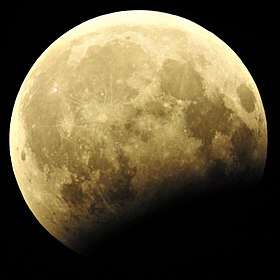December 2010 lunar eclipse
The December 2010 lunar eclipse occurred from 5:27 to 11:06 UTC on Tuesday, December 21, 2010, coinciding with the date of the December solstice. It was visible in its entirety as a total lunar eclipse in North and South America, Iceland, Ireland, Britain and northern Scandinavia.
| Total eclipse | |||||||||||||||||
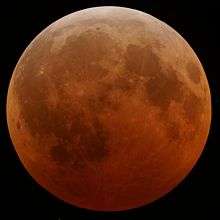 Viewed from San Jose, California | |||||||||||||||||
| Date | 21 December 2010 | ||||||||||||||||
|---|---|---|---|---|---|---|---|---|---|---|---|---|---|---|---|---|---|
| Gamma | 0.3214 | ||||||||||||||||
| Magnitude | 1.2561 | ||||||||||||||||
| Saros cycle | 125 (48 of 72) | ||||||||||||||||
| Totality | 72 minutes, 21 seconds | ||||||||||||||||
| Partiality | 208 minutes, 43 seconds | ||||||||||||||||
| Penumbral | 335 minutes, 14 seconds | ||||||||||||||||
| |||||||||||||||||
More details about the Total Lunar Eclipse of December 21, 2010.
Umbral Magnitude: 2.28065
Penumbral Magnitude: 1.25610
Gamma: 0.32139
Moon Right Ascension: 5.95
Moon Declination: 23.7
Moon Diameter: 1904.2 arcseconds
Date: Tuesday, December 21, 2010
Greatest Eclipse: 08:16:57.8 UTC
Totality: 72 minutes, 21 seconds
Perigee at approximately December 25, 2010 at 13:04:58 UTC
Saros Series: 125 (48 of 72)
Thus, 2009 began and ended on a Thursday, 2010 began and ended on a Friday, 2011 began and ended on a Saturday.
Occurrence
The eclipse of December 2010 was the first total lunar eclipse in almost three years, since the February 2008 lunar eclipse.[1]
It is the second of two lunar eclipses in 2010. The first was a partial lunar eclipse on June 26, 2010.[2]
The eclipse was the first total lunar eclipse to occur on the day of the Northern Winter Solstice (Southern Summer Solstice) since 1638, and only the second in the Common Era.[3][4]
Related eclipses
This eclipse occurred at the descending node of the moon's orbit. Lunar eclipses are always paired with a solar eclipse either 2 weeks before or after at new moon in the opposite node. In this case, it was followed by a partial solar eclipse at the ascending node on January 4, 2011, visible from Europe, northern Africa, and western Asia.
The following two lunar eclipses were also total, occurring on June 15, 2011, and December 10, 2011.
The next December solstice total lunar eclipse, as a Metonic twin eclipse, will be December 20, 2029 (19 years later), one day before solstice.
A saros series lasts for many centuries and has a similar event every 18 years and 11 days. This eclipse is the 18th of 26 total lunar eclipses in lunar saros series 125. The previous occurrence was on December 9, 1992, and the next will occur on December 31, 2028.
- See This saros
Visibility

 These simulated views of the earth from the center of the moon during the lunar eclipse show where the eclipse is visible on earth. |

In North America, the eclipse was visible in its entirety on December 21, 2010, from 12:27 a.m. to 6:06 a.m. Eastern Standard Time.[5] In the Central Standard Time zone and west, the eclipse began the night of December 20.[6] Observers along South America's east coast missed the late stages of the eclipse because they occurred after moon-set.[7]
Likewise much of Europe and Africa experienced moon-set while the eclipse was in progress. In Europe, only those observers in northern Scandinavia (including Iceland), Ireland and Britain could observe the entire event. For observers in eastern Asia the moon rose in eclipse. The eclipse was not visible from southern and eastern Africa, the Middle East or South Asia. In Japan and northeastern Asia, the eclipse's end was visible, with the moon rising at sunset. In the Philippines it was observable as a partial lunar eclipse just after sunset.[7]
Predictions suggested that the total eclipse may appear unusually orange or red, as a result of the eruption of Mount Merapi in Indonesia on October 26.[8]
Local times
| Event | HAST (UTC-10) |
AKST (UTC−9) |
PST (UTC−8) |
MST (UTC−7) |
CST (UTC−6) |
EST (UTC−5) |
AST (UTC−4) |
UTC (UTC) |
|---|---|---|---|---|---|---|---|---|
| Start penumbral (P1) | 7:29 pm(*) | 8:29 pm(*) | 9:29 pm(*) | 10:29 pm(*) | 11:29 pm(*) | 12:29 am | 1:29 am | 5:29 am |
| Start umbral (U1) | 8:33 pm(*) | 9:33 pm(*) | 10:33 pm(*) | 11:33 pm(*) | 12:33 am | 1:33 am | 2:33 am | 6:33 am |
| Start total (U2) | 9:41 pm(*) | 10:41 pm(*) | 11:41 pm(*) | 12:41 am | 1:41 am | 2:41 am | 3:41 am | 7:41 am |
| Greatest eclipse | 10:17 pm(*) | 11:17 pm(*) | 12:17 am | 1:17 am | 2:17 am | 3:17 am | 4:17 am | 8:17 am |
| End total (U3) | 10:53 pm(*) | 11:53 pm(*) | 12:53 am | 1:53 am | 2:53 am | 3:53 am | 4:53 am | 8:53 am |
| End umbral (U4) | 12:01 am | 1:01 am | 2:01 am | 3:01 am | 4:01 am | 5:01 am | 6:01 am | 10:01 am |
| End penumbral (P4) | 1:04 am | 2:04 am | 3:04 am | 4:04 am | 5:04 am | 6:04 am | 7:04 am | 11:04 am |
| (*) before midnight on Monday night, December 20 | ||||||||
Photo gallery
 Progression from São Paulo, Brazil | |
 Progression from Anchorage, Alaska | |
 Panorama showing the view from the site of the VLT | |
 Sequence from Toronto, Ontario, Canada (Sequence is in 15 minute increments, with 5 minute increments up until totality at 8:17am UTC) |
 Progression from Toronto, Canada |
 From Jacksonville, Florida, 8:29 UTC - 10:06 UTC |
 From Easton, Pennsylvania |
Individual shots, sorted by time:
 From New York City, New York, 5:35 UTC
From New York City, New York, 5:35 UTC From Arlington County, Virginia, ~7:30 UTC
From Arlington County, Virginia, ~7:30 UTC From New York City, New York, 7:38 UTC
From New York City, New York, 7:38 UTC From Seattle, Washington beginning of totality, 7:41 UTC[9]
From Seattle, Washington beginning of totality, 7:41 UTC[9]- From the Lower Mainland of British Columbia, Canada, 7:46 UTC
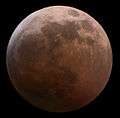 From Miami, Florida, 7:52 UTC
From Miami, Florida, 7:52 UTC.jpg) From Richardson, Texas, 7:53 UTC
From Richardson, Texas, 7:53 UTC- From Dover, Delaware, 7:54 UTC
- Lower Mainland of British Columbia, Canada during totality, 8:21 UTC
 From Toronto, Ontario, Canada, 8:26 UTC
From Toronto, Ontario, Canada, 8:26 UTC From Orlando, Florida, 8:28 UTC
From Orlando, Florida, 8:28 UTC- From Jacksonville, Florida, 8:30 UTC
 Amateur scientists observing eclipse in Villa Gesell, Argentina, 8:34 UTC
Amateur scientists observing eclipse in Villa Gesell, Argentina, 8:34 UTC From Tucson, Arizona, 8:44 UTC
From Tucson, Arizona, 8:44 UTC- From Longjing District, Taichung, Taiwan at moonrise, 9:45 UTC
Animations:
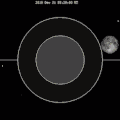
Animated Simulation 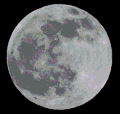 Time-lapsed animation
Time-lapsed animation
Miami, Florida
Related eclipse events
Eclipses of 2010
Lunar year series
The lunar year series repeats after 12 lunations or 354 days (Shifting back about 10 days in sequential years). Because of the date shift, the Earth's shadow will be about 11 degrees west in sequential events.
| Lunar eclipse series sets from 2009–2013 | ||||||||
|---|---|---|---|---|---|---|---|---|
| Ascending node | Descending node | |||||||
| Saros # Photo |
Date Viewing |
Type chart |
Gamma | Saros # Photo |
Date Viewing |
Type chart |
Gamma | |
| 110 | 2009 Jul 07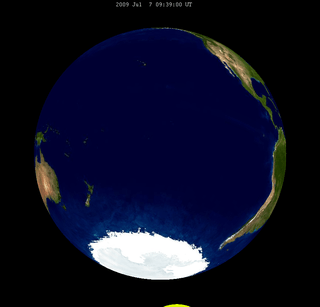 |
penumbral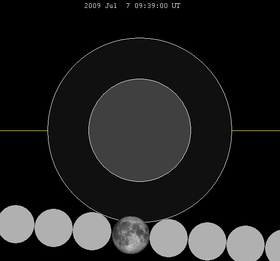 |
-1.4916 | 115 |
2009 Dec 31 |
partial |
0.9766 | |
120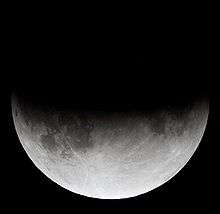 |
2010 Jun 26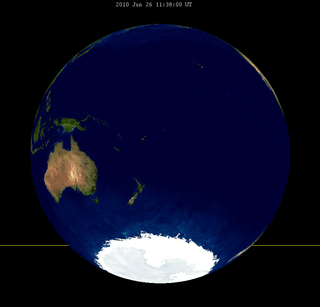 |
partial |
-0.7091 | 125 |
2010 Dec 21 |
total |
0.3214 | |
130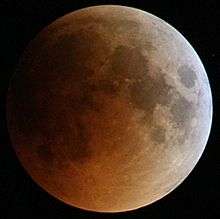 |
2011 Jun 15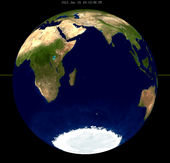 |
total |
0.0897 | 135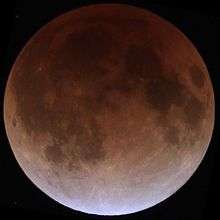 |
2011 Dec 10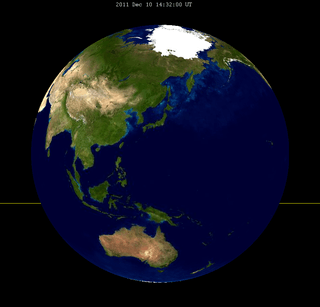 |
total |
-0.3882 | |
140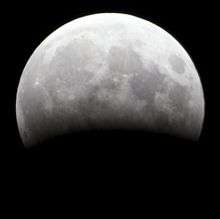 |
2012 Jun 04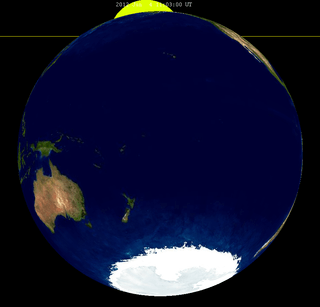 |
partial |
0.8248 | 145 | 2012 Nov 28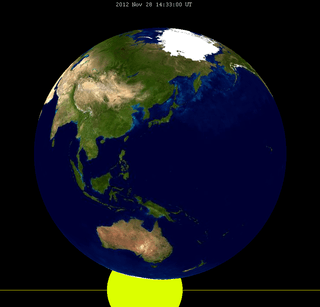 |
penumbral |
-1.0869 | |
| 150 | 2013 May 25 |
penumbral |
1.5351 | |||||
| Last set | 2009 Aug 06 | Last set | 2009 Feb 9 | |||||
| Next set | 2013 Apr 25 | Next set | 2013 Oct 18 | |||||
Metonic cycles (19 years)
The Metonic cycle repeats nearly exactly every 19 years and represents a Saros cycle plus one lunar year. Because it occurs on the same calendar date, the earth's shadow will be in nearly the same location relative to the background stars.
| Ascending node | Descending node |
|---|---|
|
|
 |
 |
Tritos series
The tritos series repeats 31 days short of 11 years at alternating nodes. Sequential events have incremental Saros cycle indices.
This series produces 20 total eclipses between April 24, 1967 and August 11, 2185, only being partial on November 19, 2021.
| Tritos eclipse series (subset 1901–2087) | ||||||
|---|---|---|---|---|---|---|
| Descending node | Ascending node | |||||
| Saros | Date Viewing |
Type chart |
Saros | Date Viewing |
Type chart | |
| 115 | 1901 Oct 27 |
Partial |
116 | 1912 Sep 26 |
Partial | |
| 117 | 1923 Aug 26 |
Partial |
118 | 1934 Jul 26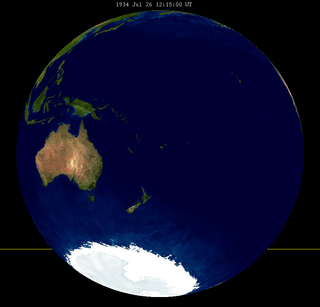 |
Partial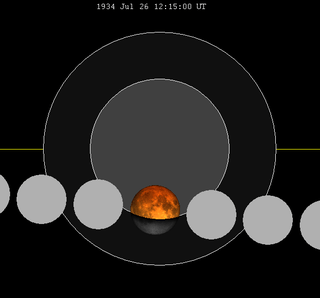 | |
| 119 | 1945 Jun 25 |
Partial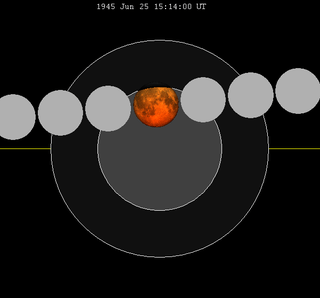 |
120 | 1956 May 24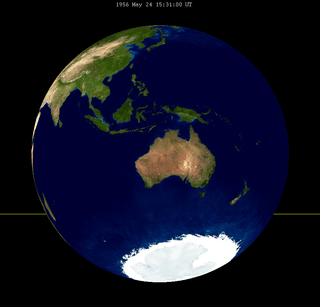 |
Partial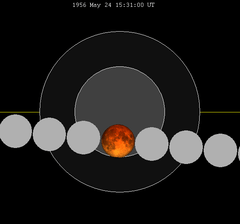 | |
| 121 | 1967 Apr 24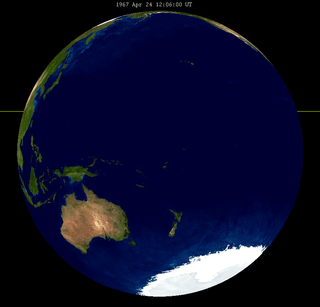 |
Total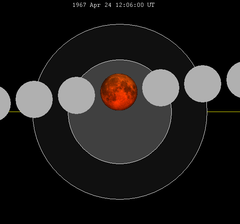 |
122 | 1978 Mar 24 |
Total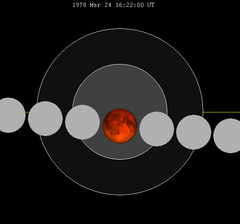 | |
| 123 | 1989 Feb 20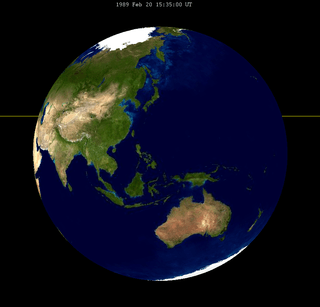 |
Total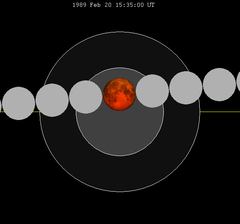 |
124 | 2000 Jan 21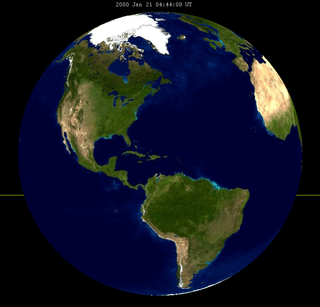 |
Total | |
| 125 | 2010 Dec 21 |
Total |
126 | 2021 Nov 19 |
Partial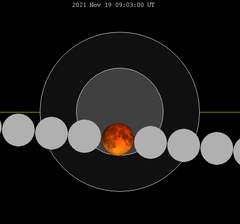 | |
| 127 | 2032 Oct 18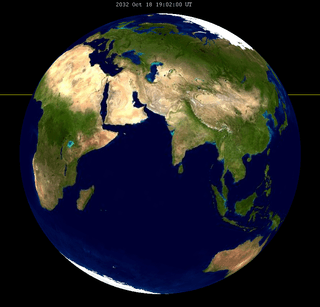 |
Total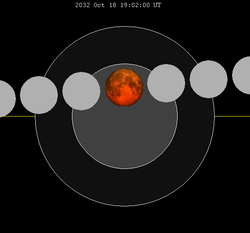 |
128 | 2043 Sep 19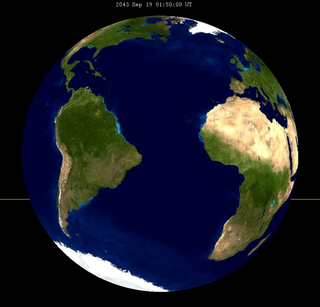 |
Total | |
| 129 | 2054 Aug 18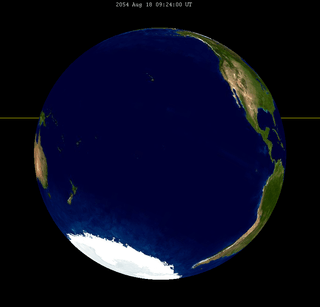 |
Total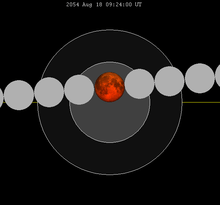 |
130 | 2065 Jul 17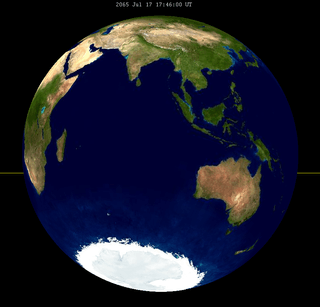 |
Total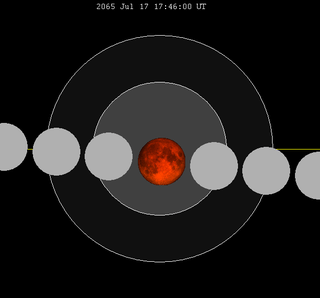 | |
| 131 | 2076 Jun 17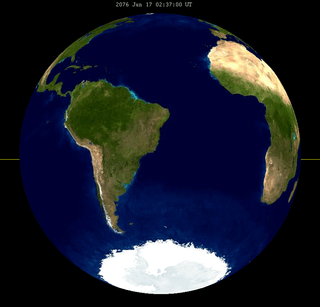 |
Total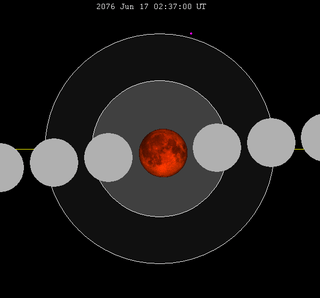 |
132 | 2087 May 17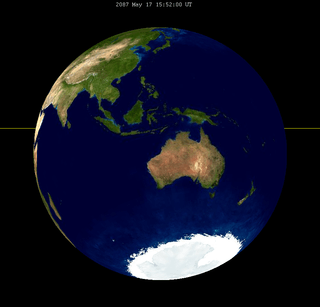 |
Total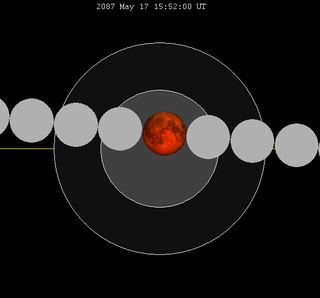 | |
| 133 | 2098 Apr 15 |
Total | ||||
Saros series
Lunar saros series 125, repeating every 18 years and 11 days, has 26 total lunar eclipses. The first was on June 17, 1704 and the last will be on March 19, 2155. The longest totality occurrence of this series (7th) was on August 22, 1812 when totality lasted one hour and 42 minutes.[10]
Half-Saros cycle
A lunar eclipse will be preceded and followed by solar eclipses by 9 years and 5.5 days (a half saros).[11] This lunar eclipse is related to two annular solar eclipses of Solar Saros 132.
| December 14, 2001 | December 26, 2019 |
|---|---|
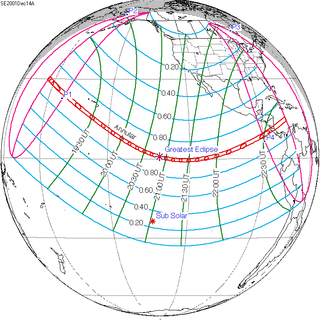 |
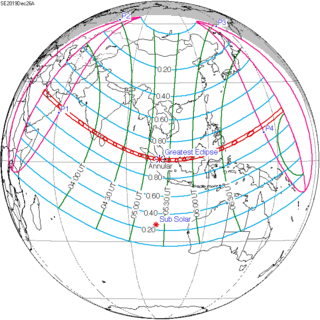 |
See also
- List of lunar eclipses
- List of 21st-century lunar eclipses
- June 2011 lunar eclipse
- December 2011 lunar eclipse
- File:2010-12-21 Lunar Eclipse Sketch.gif Chart
- 2010 12 21 – Lunar Eclipse in Jacksonville, FL
- 2010 12 21 – Lunar Eclipse Sequence
Notes
- Beatty, J. Kelly (30 December 2009). "Eclipses in 2010". Sky & Telescope. Retrieved 21 December 2010.
- "Partial Lunar Eclipse on June 26, 2010". Timeanddate.com. Retrieved 21 December 2010.
- "NASA Science News: Solstice Lunar Eclipse". Science.nasa.gov. 17 December 2010. Retrieved 21 December 2010.
- "Lunar eclipse, winter solstice to coincide". Cbc.ca. 17 December 2010. Retrieved 21 December 2010.
- Greg. "Total Lunar Eclipse of December 21, 2010". Outer Space Universe. Retrieved 3 January 2011.
- 2010 Dec 21 chart: Eclipse Predictions by Fred Espenak, NASA/GSFC
- "What Time is the Lunar Eclipse 2010 Tonight?". City State Times. Archived from the original on December 22, 2010. Retrieved 2010-12-21.
- A historic eclipse: Volcano will tint the moon in rare Dec. 21 celestial dance by Chris Roberts, El Paso Times
- Total Eclipse of the Moon in Seattle - December 21, 2010
- Listing of Eclipses of cycle 125
- Mathematical Astronomy Morsels, Jean Meeus, p.110, Chapter 18, The half-saros
External links
| Wikimedia Commons has media related to Lunar eclipse of 2010 December 21. |
- Worldwide viewing times for the December 2010 Total Lunar Eclipse
- How to Photograph the Lunar Eclipse from the NY Institute of Photography
- Full & Last Lunar Eclipse Of 2010 On December 21st
- 2010 Dec 21 chart: Eclipse Predictions by Fred Espenak, NASA/GSFC
- Hermit eclipse (Ian Cameron Smith) Total Lunar Eclipse: December 21 2010
- Animation of the December 21 2010 eclipse at shadowandsubstance.com
- Astronomical Society of the Pacific eclipse times and questions & answers
- Spaceweather.com lunar eclipse Gallery: December 21, 2010
